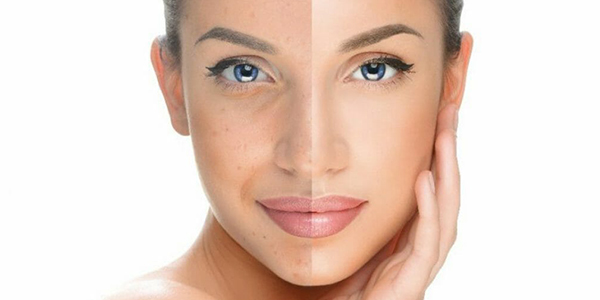Melanin is a complex polymer produced by cells called melanocytes. There are two types of melanin, pheomelanin which is yellow/red in colour, and eumelanin which is brown/black in colour, and their abundance and distribution in the skin vastly impacts skin colour. And if you guessed that melanin is what causes dark spots on your face, then you are right. In excess, melanin causes dark marks on the skin referred to as hyperpigmentation.
Hyperpigmentation marks manifest as spots on the skin that are darker than your normal skin tone. You can be genetically predisposed to hyperpigmentation, but your ethnicity and gender will play a role as well.
Luckily, there are ways to address this (very common) problem. Many botanical extracts exhibit astounding healing properties and are added to skincare products for their long list of benefits.
Prevention is the best cure
The sun emits dangerous UV rays that can be classified into three main types according to their wavelengths: ultraviolet A (UVA), ultraviolet B (UVB), and ultraviolet C (UVC). More than 90% of the UV radiation that reaches our planet is UVA, and whilst time in the sun assists humans in synthesising a super important hormone known as Vitamin D, too much exposure poses a threat to the DNA in your skin and can lead to malignant skin damage process called photocarcinogenesis.
So, one way to truly protect and help your skin is to wear sunscreen with an SPF of 15 or higher.
There are different types of hyperpigmentation
Melasma: Some forms of hyperpigmentation are linked to hormonal changes, for example, melasma in pregnant women.
Post-inflammatory hyperpigmentation: Other types of hyperpigmentation are acne-related, or due to an injury to the skin. Dark marks occur after the skin has been inflamed and therefore this type of hyperpigmentation is called post-inflammatory hyperpigmentation.
Solar lentigines: Hyperpigmentation marks caused by sun exposure are referred to as sunspots or solar lentigines. These dark spots occur when the skin is subjected to UV rays. They are typically flat on the skin, normally small, and can be tan, brown, or black in colour.
I think I have sunspots, now what?
Sunspots are also called liver spots (even though they have nothing to do with the liver) or age spots (as they tend to become more prevalent as we get older), and generally fade over time. But if you do not want to wait and would like to try something that will manage this kind of skin problem, then look out for products that contain licorice extract (Glycyrrhiza glabra).
Licorice has an active ingredient called glabridin, a chemical compound found in the root of the licorice plant and when glabridin is applied topically, it can address hyperpigmentation – whether it is as a result of UV radiation or hormones.
The marks on my face are more like patches than spots, why is that?
If you are noticing dark marks on your skin that are not small and round but rather patchy, uneven, brown and even grey, then this might be another type of hyperpigmentation called melasma (or chloasma). Melasma seems to plague women more than men and is a bigger problem for people with darker skin types, particularly in parts of the world with high sun exposure.
Studies on postmenopausal women revealed that progesterone might play a major role in the development of melasma, because those who were given progesterone were likely to develop melasma, while those who were given estrogen alone were not. So it comes as no surprise then that pregnancy and the use of oral contraceptives are the leading reasons for melasma.
What is hyperpigmentation treated with?
Thankfully, licorice extract works like a charm for melasma and helps to disperse the build-up of melanin.
Hyperpigmentation can also effectively be tackled with Vitamin B3, more oftenly called niacinamide. Niacinamide is frequently included in creams and lotions because it is easily absorbed through the skin. It helps to hydrate and support the skin’s barrier because it moderates transepidermal water loss by boosting the skin’s ability to retain moisture.
Niacinamide is water-soluble and that is why we need regular top-ups. Most animal meat is packed with this great ingredient, and you will find it in many nuts and legumes too. When used topically, niacinamide not only addresses hyperpigmentation but also prevents further pigmentation occurring by preventing melanosome transfers from melanocytes to keratinocytes.
We’ve included these beneficial ingredients in our new Pigment Corrector range, that, with continued use, will start showing noticeable improvements from just 14 days. This range consists of a gentle face wash, a day cream with SPF 30, and a night cream with Vitamin B3. We’ve also added an optional booster – a serum – to this range.
Find out more about Celltone’s new Pigment Corrector range here.
Remember that is generally a good idea to introduce new products one at a time. This will help you eliminate products that increase sensitivity. (Find out more about sensitive skin in this article.)
Available at Dischem and Clicks.
PLEASE NOTE: The information provided on this site is for educational purposes only and does not provide a substitute for professional medical advice.
If you have any product questions and want to speak to our experts about your skin struggles, you are welcome to #AskCelltone by sending us a WhatsApp message to +27 83 123 4567.
List of references:
The Application of Skin Care Product in Melasma Treatment
The effect of niacinamide on reducing cutaneous pigmentation and suppression of melanosome transfer
The Protective Role of Melanin Against UV Damage in Human Skin


